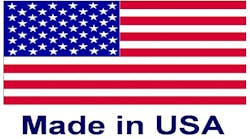Despite growing tensions over trade between the U.S. and China, consumers in both countries agree on one thing: they will pay a premium for “Made in USA” products.
More than 80% of U.S. consumers and more than 60% of Chinese consumers says they are willing to pay more for products labeled “Made in USA,” according to new research from Boston Consulting Group (BCG).
The study found about two-thirds of U.S. consumers say they will pay a premium for products in key categories, including baby food, appliances, electronics and apparel. The premium they are willing to pay ranges depending on the category, from 10% to more than 60%. BCG found that at least 20% of U.S. consumers are willing to pay a premium of 10% or more in all 10 categories. And nearly 60% of U.S. consumers had chosen a domestically produced product over less expensive Chinese goods at least once in the month before the survey.
Chinese consumers showed a similar willingness to pay more for U.S. goods, BCG found. More than 60% of Chinese consumers are willing to pay more for “Made in USA” products and nearly 50% say they prefer a product made in the U.S. to a Chinese product of equivalent price and quality. More than half had chosen U.S.-made products over less expensive Chinese goods in the previous month.
“These findings suggest that there’s a big opportunity for manufacturers and retailers to command a price premium by promoting the Made in USA brand—not only in the U.S. but also in China,” said Harold L. Sirkin, a BCG senior partner and coauthor of the research. “Retailers may want to adjust their strategies to capitalize on the strong consumer interest.”
The findings support previous BCG analysis showing that the U.S. is becoming increasingly attractive as a location for making certain products for the U.S. market and as a base for global exports. The U.S. has improved its cost competitiveness compared with China and the advanced economies of Western Europe and Japan, leading BCG to estimate that higher U.S. exports, combined with production “reshored” from China, could create 2.5 million to 5 million new U.S. jobs in manufacturing and related services by the end of the decade.
Rethinking Global Manufacturing Footprint
“The higher brand value of U.S.-made goods is a further reason why companies should rethink their global manufacturing footprint and consider the U.S. as a manufacturing location,” said Michael Zinser, a BCG partner who leads the firm’s manufacturing work in the Americas and is a coauthor of survey.
In both the U.S. and China, respondents of all age groups and income levels expressed a concern for quality, a key driver of the consumer preference for U.S.-made products. Eighty-five percent of U.S. consumers and 82% of Chinese said they “agree” or “strongly agree” that they feel better about Made in USA quality. Patriotism is another strong consideration among U.S. consumers: 93% said that they would pay more for U.S.-made goods in order to keep jobs in the U.S., and 80% said that buying U.S. products demonstrates patriotism.
In contrast to U.S. and Chinese consumers, European consumers strongly prefer products made in their own countries. More than 65% of consumers in both Germany and France said that they would be willing to pay more for products made in their home country than for those made in the U.S.




